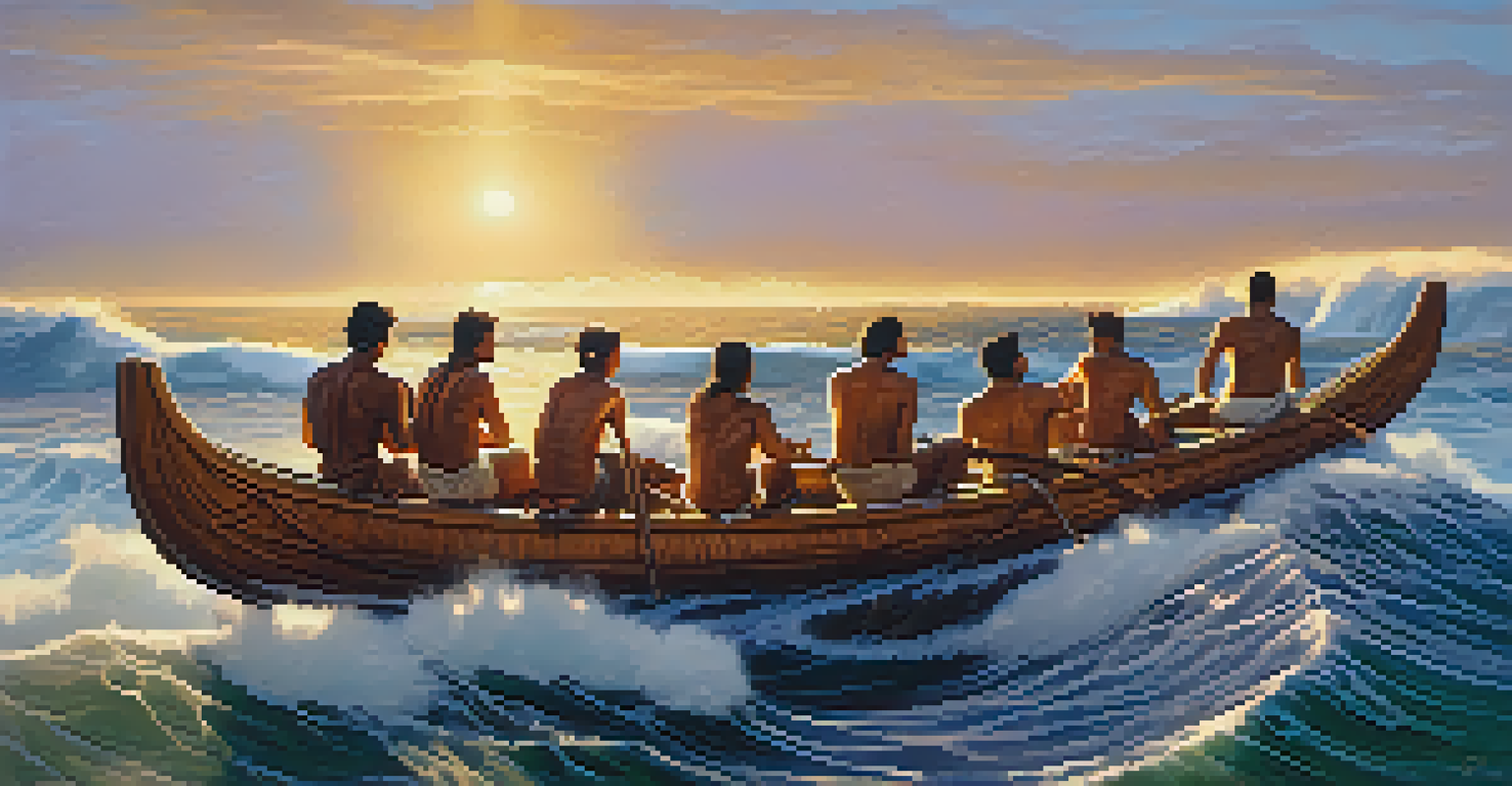The Role of Navigation in Ancient Hawaiian Voyaging Traditions

The Importance of Navigation in Hawaiian Culture
Navigation played a vital role in the survival and cultural identity of ancient Hawaiians. It wasn't just about reaching land; it was about understanding the vastness of the ocean and the stars above. The sea was a provider, and skilled navigators were respected members of society, often seen as the link between the people and their environment.
The ocean is a central part of Hawaiian culture; it is the source of sustenance, a place of adventure and exploration, and a connection to our ancestors.
Through oral traditions, knowledge of navigation was passed down from generation to generation. This deep-rooted understanding connected the voyagers to their ancestors and the land they hailed from. As they traveled, they carried with them stories and traditions that enriched their cultural tapestry.
Navigators were trained to observe subtle changes in the ocean and sky, making their craft a blend of art and science. Their ability to interpret natural signs allowed them to confidently traverse the Pacific, demonstrating an intimate relationship with the environment that still resonates in Hawaiian culture today.
Traditional Navigation Techniques Used by Hawaiians
Ancient Hawaiian navigators employed a variety of techniques, including the use of stars, ocean swells, and bird behavior. They memorized the positions of stars, which served as guiding lights during nighttime voyages. By identifying specific constellations, navigators could determine their direction and distance from their destination.

In addition to celestial navigation, they observed the ocean's waves and currents. Experienced navigators could read the subtle changes in swell patterns to discern whether they were approaching land or deep water. This skill was crucial for safe and accurate navigation across vast distances.
Navigators: Cultural Guardians
Ancient Hawaiian navigators were revered as cultural guardians, preserving vital knowledge and traditions through storytelling and observation of the natural world.
Bird behavior also played a significant role in navigation. Certain birds, such as the albatross, would only fly close to land, providing vital clues to navigators about their proximity to islands. By understanding these natural indicators, navigators could confidently chart their course through the expansive ocean.
Canoe Design and Its Role in Navigation
The design of traditional Hawaiian canoes, known as wa'a, was intricately linked to navigation. These canoes were crafted for stability and speed, allowing them to handle the unpredictable Pacific waters. Their double-hulled structure provided greater buoyancy, making long voyages more feasible.
Navigating the Pacific was not just about reaching a destination, it was about understanding the environment and our place within it.
Canoe builders utilized materials from the environment, such as koa wood and palm fibers, to create sturdy vessels. The craftsmanship involved in constructing a wa'a was a skill passed down through generations, reflecting the deep respect Hawaiians had for their natural resources.
The canoes themselves were equipped with various tools that aided navigation, such as paddles and sails. Sails harnessed the wind, allowing navigators to travel efficiently, while paddles were essential for maneuvering in tight spots. Together, these elements made the wa'a a remarkable tool for exploration and adventure.
The Role of Oral Traditions in Navigation Knowledge
Oral traditions played a crucial role in preserving navigation knowledge among ancient Hawaiians. Storytelling was not just a means of entertainment; it was a way to pass down vital information about routes, celestial patterns, and environmental cues. This rich oral history ensured that crucial navigation skills were not lost over time.
Elders were often the keepers of this knowledge, teaching the younger generation through stories and practical lessons. These narratives often included the experiences of past voyagers, highlighting both their triumphs and challenges. This interconnectedness reinforced the importance of navigation as a communal legacy.
Revival of Ancient Techniques
There is a modern resurgence in ancient Hawaiian navigation practices, fostering cultural pride and environmental awareness among new generations of navigators.
By engaging with these stories, young navigators developed a sense of identity and purpose. They learned to respect the ocean and its mysteries, understanding that their role was not just as voyagers but as custodians of a rich cultural heritage that valued exploration and discovery.
Modern Revival of Ancient Navigation Practices
In recent years, there has been a resurgence of interest in ancient Hawaiian navigation practices. Organizations like the Polynesian Voyaging Society have been at the forefront of reviving these traditions, offering training programs and voyages that honor the skills of ancestral navigators. This revival not only preserves history but also fosters a sense of cultural pride.
Modern-day navigators are learning the same techniques their ancestors used, connecting with the ocean and the stars in a profound way. By embracing these practices, they are keeping the spirit of exploration alive while educating others about the significance of their heritage. Voyages like the Hōkūleʻa, a traditional voyaging canoe, showcase the resilience of Hawaiian culture.
This revival is also a way to promote environmental awareness, as these navigators advocate for sustainable practices that respect the ocean. By respecting their roots, modern navigators bridge the past and the future, ensuring that ancient wisdom continues to guide them on their journeys.
Navigational Tools: Then and Now
Ancient Hawaiian navigators relied on their keen observations and natural tools, but as technology has advanced, so too have the methods of navigation. While the stars and ocean swells remain vital, modern tools like GPS and digital maps have transformed the way we navigate. However, many navigators still emphasize the importance of traditional techniques.
The integration of modern tools has allowed for safer and more efficient voyages, but it also raises questions about the loss of traditional knowledge. For many navigators, the challenge lies in balancing the use of technology with the rich heritage of their ancestors. This blend of old and new highlights the adaptability of Hawaiian culture.
Balancing Tradition and Technology
Today's navigators blend traditional techniques with modern tools like GPS, ensuring the survival of ancestral wisdom while enhancing safety and efficiency.
Today, many voyaging groups encourage a holistic approach to navigation, combining ancient wisdom with modern technology. This not only honors the past but also prepares future generations to navigate the waters of the Pacific while staying connected to their cultural roots.
The Cultural Significance of Navigation in Hawaii
The art of navigation is deeply woven into the fabric of Hawaiian culture, representing more than just a means to an end. It embodies exploration, adventure, and a profound connection to the land and sea. This cultural significance is celebrated in festivals, storytelling, and educational programs that share the rich history of Hawaiian voyaging.
Navigators are seen as cultural ambassadors, carrying the stories and traditions of their ancestors across the ocean. Their voyages serve as a reminder of the resilience and ingenuity of the Hawaiian people. This cultural pride fosters a sense of community and unity among those who share a connection to the sea.

As ancient navigation practices are revived and celebrated, they inspire a renewed appreciation for the ocean and its role in Hawaiian identity. This ongoing journey of discovery emphasizes the importance of preserving cultural heritage while navigating the future.